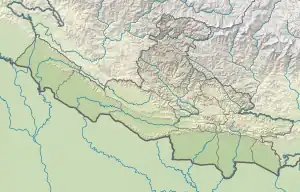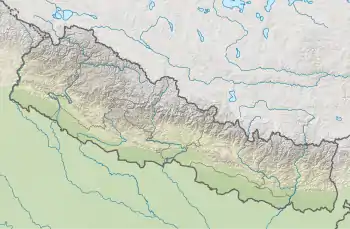Sunilsmriti Rural Municipality
Sunilsmriti is a Rural municipality located within the Rolpa District of the Lumbini Province of Nepal. The rural municipality spans 156.55 square kilometres (60.44 sq mi) of area, with a total population of 28,213 according to a 2011 Nepal census.[1][2]
Sunilsmriti (RM)
सुनिलस्मृति गाउँपालिका | |
|---|---|
 Sunilsmriti (RM) Location  Sunilsmriti (RM) Sunilsmriti (RM) (Nepal) | |
| Coordinates: 28.24°N 82.72°E | |
| Country | |
| Province | Lumbini |
| District | Rolpa |
| Wards | 7 |
| Established | 10 March 2017 |
| Government | |
| • Type | Rural Council |
| • Chairperson | Mr. Gunendra Gharti |
| • Vice-chairperson | Mrs. Bagmati Chhetrini |
| • Term of office | (2017 - 2022) |
| Area | |
| • Total | 156.55 km2 (60.44 sq mi) |
| Population (2011) | |
| • Total | 28,213 |
| • Density | 180/km2 (470/sq mi) |
| Time zone | UTC+5:45 (Nepal Standard Time) |
| Headquarter | Mijhing |
| Website | sunilsmritimun |
On March 10, 2017, the Government of Nepal restructured the local level bodies into 753 new local level structures.[3][4] The previous Mijhing, Aresh, Khungri, Ghodagaun, Tewang, Gajul and portion of Phagam VDCs were merged to form Sunilsmriti Rural Municipality. Sunilsmriti is divided into 7 wards, with Mijhing declared the administrative center of the rural municipality.
Demographics
At the time of the 2011 Nepal census, Sunilsmriti Rural Municipality had a population of 28,213. Of these, 98.4% spoke Nepali, 0.5% Kham, 0.5% Magar, 0.2% Urdu, 0.1% Hindi, 0.1% Newar, 0.1% Tharu and 0.1% other languages as their first language.
In terms of ethnicity/caste, 34.1% were Magar, 33.0% Chhetri, 13.6% Kami, 5.5% Sanyasi/Dasnami, 3.8% Hill Brahmin, 3.2% Damai/Dholi, 3.1% Thakuri, 1.7% Sarki, 0.5% Musalman and 1.5% others.
In terms of religion, 96.3% were Hindu, 2.7% Buddhist, 0.5% Muslim, 0.2% Christian and 0.3% others.[5]

References
- "District Corrected Last for RAJAPATRA" (PDF). www.mofald.gov.np. Retrieved 17 July 2018.
- "स्थानीय तहहरुको विवरण" [Details of the local level bodies]. www.mofald.gov.np/en (in Nepali). Ministry of Federal Affairs and Local Development. Retrieved 17 July 2018.
- "New local level structure comes into effect from today". www.thehimalayantimes.com. The Himalayan Times. 10 March 2017. Retrieved 17 July 2018.
- "New local level units come into existence". www.kathmandupost.ekantipur.com. 11 March 2017. Retrieved 18 July 2018.
- NepalMap Demographics
